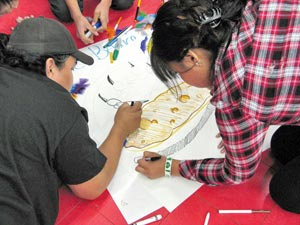Native HOPE: Teaching teens how to really talk
By Noel Lyn Smith
Navajo Times
RED MESA, Ariz., Dec. 12, 2011


TOP: Red Mesa High freshmen make a presentation to their peers during the Native HOPE suicide prevention workshop Dec. 1 at Red Mesa Junior High in Red Mesa, Ariz. (Courtesy photo)
BOTTOM: Red Mesa High freshman Anrael Eldridge, right, and group leader North Bear Fragua, left, work on their group's shield during the Native HOPE suicide prevention workshop Dec. 1 at Red Mesa Junior High. (Times photo - Noel Lyn Smith)
Most suicide prevention workshops consist of lectures and video presentations but Native HOPE takes the hands-on approach, said Darlene Begay, a health promotion coordinator at Four Corners Regional Health Center.
The Dec. 1 workshop at Red Mesa aimed to get the students to be pro-active, to reach out and intervene before they lose another friend to suicide.
"We are trying to think of innovative ways to get the message across," Begay said.
Organizers also want to teach students that it is OK to ask for help.
Native HOPE is a culture-based peer-counseling program that works to prevent suicide and related risk factors such as substance abuse, violence, trauma, stress and depression.
The curriculum is based on the theory that Native youth can break the "code of silence" surrounding suicide and learn to help and support each other.
The teachings draw on Native culture, traditions, spirituality, ceremonies and humor.
"Youth have the most influence on each other. I say lead your peers into glory rather than the gutter," said Clayton Small, who co-wrote the curriculum.
Eight out of 10 suicides are preventable by breaking that "code of silence," Small told the students.
In order to break the code, students need to learn that it is OK to talk about their problems with friends, family or a counselor and they need to understand that they are not alone with facing a situation.
Small admits that breaking the silence is not easy because some teens do not want to be viewed as a snitch. Others do not trust adults and think their problem will not be taken seriously.
"So they stay silent while their friends suffer or end up a fatality," he said. "We challenge them with the right thing to do is break the code of silence and intervene and get some help. Even if that means they never talk to you again but at least you helped them continue to live."
He also noted that 50 percent of Native teen suicides involve alcohol and substance abuse, that Native males are more likely to commit suicide, and that the cause of suicide can be linked to substance abuse, stress, depression and historic trauma.
"If we give them some tools maybe they can help their peers who are struggling," he said.
After the introduction session, students formed nine groups and asked to develop a chart listing their greatest strengths and to describe a behavior they would like to change, along with creating a group name, a shield with the name of their group and a group cheer.
Freshman Anrael Eldridge drew a huge bear claw on her group's poster board to represent their name, "Cheii Bears Diné Carnivore."
As she completed the design, group leader Bear North Fragua encouraged teamwork.
Small said that this exercise was teaching the students to rely on one another to address a situation and to develop an identity.
Freshman Shantel Hunt said she was learning how to deal with anger by talking to her friends or channeling her emotion into exercise.
"I think it's good, it's cool and fun," she said about the workshop.
Parent volunteer Madeline Todechine said the lessons she learns from the class could help her create discussion with her two teenage sons.
"This is interesting, something new," she said.
After lunch students were asked to pick a rock from outside that they think best represent their character and explain why they selected that rock.
Sophomore Tricia Williams held a round granite-like rock in her hand.
"It's not too big or not too small but just enough to be strong," Williams said.
During the course of the workshop, Williams said she learned that she couldn't respond to every problem with aggression.
"It's not good," she said.
As part of the curriculum, the students will develop a Native HOPE Youth Council to continue advocating for peer-to-peer support groups and organize activities for teens in the community.
The presentation to Red Mesa students is one in many that Native HOPE has conducted on the Navajo Nation.
The program has also visited schools in Chinle, Crownpoint, Kayenta, Shiprock and Whitehorse Lake, and Navajo Preparatory School in Farmington.
Presentations are planned at Tohatchi, Wingate and Monument Valley high schools in 2012.
Information: www.nativeprideus.org.

